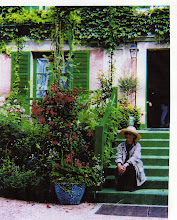
Our first annual (?) Organic Vegetable Gardening Fete! May 9, 2009 10 am - 4 pm
Hosted by The Gardens - Nantucket Wildflower at 84 Egan Lane ( off Old South Rd)
This will be a series of formal workshops (see list below) to give hands-on experience in organic gardening to non-gardeners, and new information to non-organic gardeners. We will also have informal "Garden Gams" on going through the day.
Gardeners experienced with growing organic vegetables and the various specific soil and planting techniques on Nantucket will be leading each workshop.
Formal workshops: you will need to register for these
Raised Bed Gardens - check out This Old House video, 3 part workshop
Square Foot Gardens - book, and on-line info
Lasagna Gardens - book, and on-line info
In Ground Gardens
Container Gardens
The informal Garden Gams will cover subjects ranging from Bees, Compost, Fencing, Seed an Seeding, Perennial crops, Chickens, Organic Lawn care, Beneficial Insects
For those who might be new to Nantucket, "Gam" is an old Nantucket word for a talk e.g.. " had a good gam with Janet at the post office today"
Watch this blog for updates, information on organic kitchen gardening.
We are asking that you register so we can keep groups a workable size, and we will need to have handouts printed - also why we are charging an admission fee, to help cover some of the
costs.
Registration: eatyourgarden@hotmail.com, or call: 508-228-2093 expect to leave a message, you will be called back with a confirmation. Fees will be paid on admission.
Many great thanks to the Nantucket Land Council - just for being themselves - but also for picking up the advertising costs for this event that more Islanders might know about the event, and be able to attend.
Workshop leaders:
Raised beds : Dane from Seaside Gardens will build the frame, tips on what wood to use, how to secure the frame. Chapin Kline will be demonstrating how to fill the new raised bed, we will show how to mix native soils with composts, manures, organic fertilizers ( what to use, how much, what it should look like when you are finished) Natalie will be leading the planting of the Raised beds in The "Square Foot Gardening" method - this workshop will be in 3 sections to allow time for question and answer times. Just in, Winnie of Graves Fencing is going to build a classic "square foot garden" frame - but for seniors - a 4'x4' frame 30 " high.
Lasagna Gardening: This workshop will be lead by Claudia Butler and Dylan Wallace. Known as "Native Gardeners" they have been focused on organic gardening for some time as many of you know, their pickup even runs on vegetable oil! Lasagna refers to a method of layering materials to build a great organic soil
In Ground Garden: We are fortunate to have several Sloseks, of Moors End Farm, who have volunteered for this workshop - essentially this program will demonstrate what you do with native soil - the good, the bad and of course the ugly. We enjoy mostly sandy soils here, but there are varieties of that, and then there are those clay pockets. How to identify what your soil is, what amendments do you need, how much? what fertilizers to use, how to apply it, how much to apply - what should your mix look like when it is ready to plant
Container Gardening: Ellie Huyser, the cheery soul who persons the check out counter at Valeros grew all her vegetables in containers last year - and had great success, so she will share her experiences with this workshop - what soil to use in a container, what fertilizers, how much to apply, when to apply.
Ringmaster: Cinda Gaynor, thats me - I'll be around adding my advice, direction, tips from my experience, filling in where needed - and encouraging the Garden Gam with various people who will join us through the day with great experience in all sort of garden related information: beekeeping, compost, Caroline Ellis is bringing her "girls" ( chickens) to share their tales of life in Quaise Pasture, Ashley Mott from Pumpkin Pond Farm is taking about beneficial insects. , Laura Simon will be here to discuss seed issues - she has several companies who have sent their catalogues to share, fencing issues, Jason Sullivan will give us an overview of Organic Lawn Care - the Gam is wide open for garden talk - join in!
I do not know who created this delightful poster,
I wish I did so I could thank them. Hope you enjoy it
as much as I have










